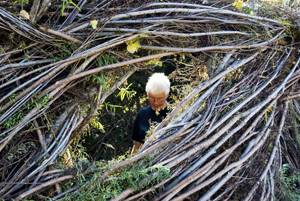A Portal in the Park

Artist Patrick Dougherty works on his sculptures at Ada Hayden Park on Saturday, Oct. 13, 2008. Dougherty travels the world creating sculptures out of living material that are indigenous to the area he is working in. Photo: Chris Potratz/Iowa State Daily
October 16, 2008
Tucked away in a small clearing behind a glistening lake, four to five dedicated volunteers snipped, wove and trimmed away every day for three weeks. They weren’t park rangers rehabilitating wildlife, nor were they regular visitors on their morning jogs. They were local residents engrossed in constructing a 300-foot-long tunnel out of twigs and branches.
The newest addition to Ada Hayden Heritage Park, a free-standing tunnel sculpture made of indigenous materials, was unveiled Thursday after weeks of gathering, sorting and building.
Led by internationally renowned sculptor Patrick Dougherty, who designed the structure, the volunteer crew installed hundreds of willow saplings into the park as a part of a joint project between the City of Ames, the Ames Parks and Recreation Department and the Public Arts Commission, in order to spruce up the park.
When deciding what do with the fairly vast stretch of land available at the park, the commission ultimately chose to keep the space for large public art pieces as to attract more visitors into the park.
“It’s unlike any other art piece in our community — it’s not like it’s something someone made sitting in their studio,” said Dan Naegele, member of the Ames Public Art Commission and associate professor of architecture. “It brings temporal dimension; you can actually touch it.”
A man whose own house is made of cedar and rocks, Dougherty has created public art in countries such as Denmark, England and Japan.
His project in Ames features a grid of interlocking saplings from rooted, existing trees woven together to form a long doorway, pathway or tunnel, emphasizing the open sky and different views of the park.
Dougherty said the intent was to “get another view of nature as it might be encapsulated through a telescope or a window. You already have people here that are happy because they’re out here walking, and you hope that they will spend a minute to have a detour walk through here. Once people have seen it, accommodated themselves to it, they like it.”
Originally from North Carolina, Dougherty studied health care at the University of Iowa. He practices what he calls “classical stick architecture,” sculpting eight to 10 large-scale temporary pieces on-site from natural materials per year for his company, StickWorks. In early October, Dougherty came to campus to talk about his the project and his artwork, calling for students and community members to come and volunteer.
“I love building things. Once I build something great, I turn it over to someone else and it’s [then] their job to look at it,” Dougherty said at the event. “So I don’t feel like I ever leave a community — by the time that I’ve worked in that space, by the time that people have walked by again and again and seen it, talked to me, and had people in the community be open to it, then everybody kind of loves that space. I can [then] feel really good about walking away from it … and going on to the next thing.”
As an aspiring architect in the College of Design, Asa Houston, sophomore in pre-architecture, first heard about the project in his design cultures class and decided to help out.
“It’s amazing, really, how primitive [it is]. Here we are, in 2008, and we’re building something with sticks. The process of something slowly gesturing, slowly coming together … is great,” Houston said. “It’s a good idea to come out and see a real professional artist work and actually work with him to see the process of creating a masterpiece.”
Dougherty’s sculpture is now up for public viewing in Ada Hayden Heritage Park.
















